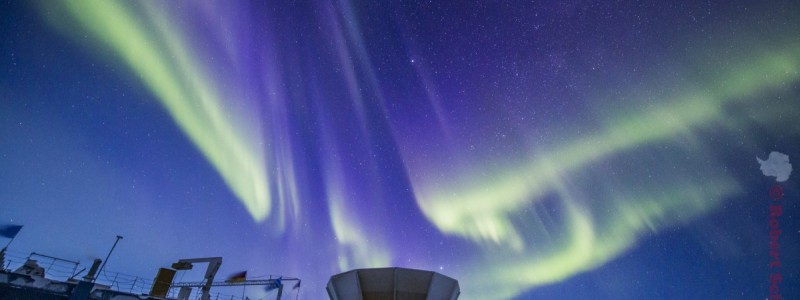Podcast episode 07 - Published 10 August, 2017 by Nicholas O'Flaherty
Tweet
90 degrees South
The geographic South Pole! Along with the North Pole, it’s the only degree of latitude that doesn’t form a circle running parallel to the equator. It’s simply a point; the southernmost point on Earth. All lines of longitude, and time zones, meet there. At the South Pole, all directions are North.
The first humans to arrive at the Pole were Roald Amundsen and his four companions on the 14 December 1911. Scott and his team followed 34 days later. Richard Byrd flew over it in 1929. It wasn’t until October 1956 that the next humans walked on the South Pole when Gus Shinn of the US Navy became the first person to land a plane there. Three months later, in January 1957, the US Navy completed the first South Pole station, beginning a continuous presence right up to today.
Amundsen-Scott South Pole Station, National Science Foundation
The third and most recent version of the US Amundsen-Scott South Pole Station, as it’s now called, is the spectacular elevated building, an engineering marvel that was completed in 2008. To meet the enormous needs of the U.S. scientific research community, the U.S. Antarctic Program is managed by National Science Foundation (NSF).
The South Pole Station is located at an altitude of 2800m, atop an ice sheet that is more than 2.5km deep. The bedrock far below is a mere 100m above sea level. The surface of the ice sheet at the Pole moves approx 10m per year in the direction of longitude 40 degrees West, which is towards the Weddell Sea.
Each year, the South Pole experiences only one sunrise (at the September equinox) and one sunset (at the March equinox). So for six months, the Sun disappears entirely. The last flight of the season leaves the Pole in February, with the first plane arriving back in November. For nine months of the year, a core winter-over group, usually about 45-50 people, maintain the base through the long dark Antarctic winter.
Wintering over at the South Pole, thirteen times!
This week on The Antarctic Report podcast, we speak to German astronomer, Robert Schwarz. He’s currently at the South Pole, as the winter comes to an end. This is the 13th time that Robert has wintered over, and that’s a record - no one has spent more time at the South Pole than Robert Schwarz!
Robert works at the South Pole for the University of Minnesota on a microwave telescope array, which is a series of telescopes that work together as one. It’s called the SPUD Keck project which researches the Cosmic Microwave Background, the electromagnetic radiation left over from Big Bang.
It took a few weeks to sort out the right time to call Robert for the interview while he’s at the South Pole. We spoke to him in late July this year, 2017.
Satellite communications
In order to describe the challenges in contacting the South Pole, let me give a brief summary of the satellite communications systems.
Satellites in a geosynchronous orbit, are in a special high altitude orbit, about 35,773km above the equator, traveling in the same direction as the Earth's rotation. At that altitude and velocity, the satellite appears to remain stationary from the point of view of an observer on Earth. It almost, but not quite stays stationary above a fixed point.
In fact, what actually happens is that over 24 hours, geosynchronous satellites do move slightly in a north-south pattern, leaving a trace pattern on the surface of the Earth that looks like a figure eight. The amount of north-south movement a satellite makes in that pattern is called its inclination.
Most geosynchronous satellites have a low inclination, in other words, they don’t move too much north or south of their celestial equatorial position. And that’s deliberate of course, to enable them to do such things as broadcast satellite TV to satellite dishes mounted on homes around the world.
If you’re at the South Pole however, you can’t see these satellites with low inclination, because they never appear above the horizon. The curvature of the Earth simply blocks them from view.
NASA's TDRS satellite (Tracking and Data Relay Satellite)
But there are exceptions. Some geosynchronous satellites do have high inclinations, with the figure eight pattern on the ground extending further north and south of the equator. For the South Pole, the inclination needs to extend to a minimum 8.7 degrees South of the equator, at which point, geosynchronous satellites pop up above the horizon, enabling communication.
There are currently three geosynchronous satellites with high north-south inclinations that the South Pole station specifically use.
The NASA TDRS, or Tracking and Data Relay Satellite, is visible for about 4 hours from the South Pole, over a 24 hour period. It’s also used by the International Space Station and the Hubble Space Telescope. For South Pole observers, it reaches as high as 5 degrees above the horizon. At its highest service rate, the satellite offers transmission speeds up to 75 times the speed of a typical residential Internet connection. During those brief 4 hours at the Pole, the high rate service channel is used exclusively to transfer science and operational data files.
It was using the TDRS satellite, that I was able to speak with Robert Schwarz at the South Pole back in July.
Useful links
For information on sateliite communications at the South Pole, go to: South Pole Satellite FAQs
More information on the SPUD Keck Telescope Array can be found here: Keck Array Overview
Robert Schwarz has information on his work and videography at: Iceman's South Pole page
Feature image: Aurora Australis display above the Martin A. Pomerantz (MAPO) building, which houses the SPUD Keck Telescope Array, South Pole; credit: Robert Schwarz